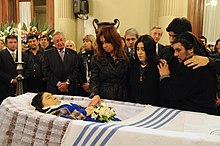Mercedes Sosa
[7] Sosa and her first husband, Manuel Oscar Matus, with whom she had one son, were key players in the mid-60s nueva canción movement (which was called nuevo cancionero in Argentina).
Sosa "spent the late 1960s building her audience in Europe and among the cosmopolitan middle class in Buenos Aires, becoming in the process a much bigger star" than her contemporaries.
[citation needed] In later years, she performed and recorded extensively, broadening her repertoire to include material from throughout Latin America.
In the early 1970s, Sosa released two concept albums in collaboration with composer Ariel Ramírez and lyricist Félix Luna: Cantata Sudamericana and Mujeres Argentinas (Argentine Women).
She also recorded a tribute to Chilean musician Violeta Parra in 1971, including what was to become one of Sosa's signature songs, Gracias a la vida.
[7][9] Sosa returned to Argentina from her exile in Europe in 1982,[9] several months before the military regime collapsed as a result of the Falklands War, and gave a series of concerts at the Teatro Ópera in Buenos Aires, where she invited many of her younger colleagues to share the stage.
In subsequent years, Sosa continued to tour both in Argentina and abroad, performing in such venues as the Lincoln Center in New York City and the Théâtre Mogador in Paris.
[14] [15] While she was outright in her political stances, Sosa said the following on the position of the artist: “An artist isn’t political in the party political sense – they have a constituency, which is their public – it is the poetry that matters most of all.”In a career spanning four decades, she worked with performers across several genres and generations, folk, opera, pop, rock, including Martha Argerich, Andrea Bocelli, David Broza, Franco Battiato, Jaime Roos, Joan Baez, Francis Cabrel, Gal Costa, Luz Casal, Lila Downs, Lucio Dalla, Maria Farantouri, Lucecita Benitez, Nilda Fernández, Charly Garcia, León Gieco, Gian Marco, Nana Mouskouri, Pablo Milanés, Holly Near, Milton Nascimento, Pata Negra, Fito Páez, Franco De Vita, Lourdes Pérez, Luciano Pavarotti, Silvio Rodríguez, Ismael Serrano, Shakira, Sting, Caetano Veloso,[4] Julieta Venegas, Gustavo Cerati and Konstantin Wecker[9] Sosa participated in a 1999 production of Ariel Ramírez's Misa Criolla.
[26] Her website featured the following: "Her undisputed talent, her honesty and her profound convictions leave a great legacy to future generations".
[27][29] Sosa's obituary in The Daily Telegraph said she was "an unrivalled interpreter of works by her compatriot, the Argentine Atahualpa Yupanqui, and Chile's Violeta Parra".
[7] Helen Popper of Reuters reported her death by saying she "fought South America's dictators with her voice and became a giant of contemporary Latin American music".
The doodle was showcased in Argentina, Chile, Uruguay, Paraguay, Bolivia, Peru, Ecuador, Cuba, Iceland, Sweden, Serbia, Greece, Israel and Vietnam.




